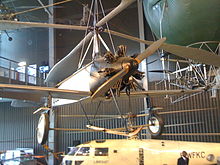Musée de l'air et de l'espace
 | |
 | |
| Established | 1919 |
|---|---|
| Location | Paris – Le Bourget Airport Le Bourget, France |
| Type | Aviation museum |
| Website | www.museeairespace.fr |
The Musée de l'air et de l'espace, (English: Air and Space Museum), is a French aerospace museum, located at the south-eastern edge of Le Bourget Airport, north of Paris, and in the commune of Le Bourget.[1] It was inaugurated in 1919 after a proposal by the celebrated aeronautics engineer Albert Caquot (1881–1976).
Description
Occupying over 150,000 square metres (1,600,000 sq ft) of land and hangars, it is one of the oldest aviation museums in the world. The museum's collection contains more than 19,595 items, including 150 aircraft, and material from as far back as the 16th Century. Also displayed are more modern air and spacecraft, including the prototype for Concorde, and Swiss and Soviet rockets. The museum also has the only known remaining piece — the jettisoned main landing gear — of the L'Oiseau Blanc (The White Bird), the 1927 aircraft which attempted to make the first Transatlantic crossing from Paris to New York. On 8 May 1927, the aircraft took off from Le Bourget, jettisoned its main landing gear (which is stored at the museum), which it was designed to do as part of its trans-Atlantic flight profile, but then disappeared over the Atlantic, only two weeks before Lindbergh's monoplane completed its successful non-stop trans-Atlantic flight to Le Bourget from the United States.
Other items of interest range from a gilded bronze medallion of the Montgolfier brothers, created in 1783 by Jean-Antoine Houdon (1741–1828), the Biot-Massia glider (1879), an 1884 electric motor by Arthur Constantin Krebs (1850–1935), the rear gondola of the 1915 Zeppelin LZ 113, equipped with 3 Maybach engines, type HS, a 1916 SPAD VII aircraft by Blériot-SPAD and flown by French flying ace Georges Guynemer in World War I, a 1917 Airco DH.9 aircraft by Geoffrey de Havilland (1882–1965), and a 1918 Junkers D.I aircraft by Hugo Junkers (1859–1935), to the 1961 Dassault Mirage IIIC by Marcel Dassault (1892–1986), an SSBS S3 surface-to-surface ballistic missile commissioned in 1981, and a 2002 Dassault-Breguet Super Étendard model.
Aircraft on display
Grand Gallery

Between the Wars and Light Aviation Hall



World War II Hall
- Bücker Bü 181
- CASA 2.111
- Dewoitine D.520
- Douglas C-47 Skytrain
- Douglas DC-3 cockpit
- Focke-Wulf Fw 190
- North American P-51 Mustang
- Republic P-47 Thunderbolt
- Supermarine Spitfire Mk XVI
- V-1 flying bomb
Rosette Hall
Prototype Hall

Concorde Hall
- Concorde (two, F-WTSS prototype and Air France F-BTSD)
- Dassault Mirage IV
- Dassault Mirage 4000
- Eurocopter X3[2]
Tarmac/Exterior Exhibit
- Boeing 747
- Ariane 1 (model)
- Ariane 5 (model)
See also
References
- ^ "Press Kit 100 years of the International Aerospace Show Paris Le Bourget 15 to 21 June 2009." (Archive) French Aerospace Museum. p. 3 Retrieved on 24 April 2010.
- ^ "Airbus Helicopters X3 makes its new home at France's national Air and Space museum" Airbus PR, 19 June 2014. Accessed: 19 June 2014. Archive
